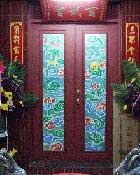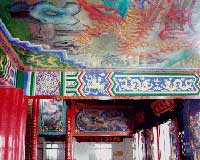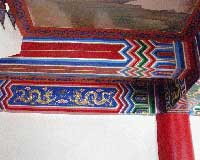 |
|
| Fanciful Latticework on Doors and Windows |
| CCTV.COM 2003-07-10 13:07:23 |
|
 Latticework of diverse, elaborate designs which characterizes doors and windows of traditional Chinese buildings has exerted a far-reaching influence on Chinese architectural ornament. Latticework of diverse, elaborate designs which characterizes doors and windows of traditional Chinese buildings has exerted a far-reaching influence on Chinese architectural ornament.
“In ancient times, one's house usually told much about his status and wealth. So when he had a house built for him, he lavished attentions on its architecture. Architectural ornament became very popular during Song times over 1,000 years ago. Both doors and windows were decorated with beautiful latticework motifs. These motifs, derived from traditional designs, reflected Chinese culture,” said Ma Weidu, curator, Guangfu of Classical Art Museum of Beijing.
Latticework motifs on doors and windows are mostly derived from traditional designs with auspicious meanings. Storks and deer are patterns symbolizing longevity and good health. Latticework is often enhanced by various motifs such as arabesques, the Chinese character for happiness, and figures and episodes from local operas and folk stories. Geometric patterns are also favored because they are simple yet graceful.
 “Cross motifs are popular for doors and windows. There are also motifs based on the symbols of the five elements and the eight trigrams. Some doors and windows are decorated with interlaced cross patterns. Others feature geometric variations of the swastika, a Buddhist symbol. There are countless variations of lattice designs using this figure,” said Jin Zhilin, professor of Central Academy of Fine Arts. “Cross motifs are popular for doors and windows. There are also motifs based on the symbols of the five elements and the eight trigrams. Some doors and windows are decorated with interlaced cross patterns. Others feature geometric variations of the swastika, a Buddhist symbol. There are countless variations of lattice designs using this figure,” said Jin Zhilin, professor of Central Academy of Fine Arts.
In ancient times, woodcarving was well developed in South China. Windows and doors of the provinces of Zhejiang and Anhui were often elaborately decorated with latticework and bas-reliefs. In the 15th century, carpenters and jointers began to move to the north from Zhejiang Province. As a result, doors and windows featuring patterns of South China style could also be found in the north. By the end of the 16th century, doors and windows sometimes became a sumptuous part of a building, with great displays of marquetry, carving, and inlay. Doors and windows in ancient China were different in style from place to place. Those of China's coastal provinces of Fujian and Guangdong were usually gorgeously painted. But people living along the lower Yangtse River stressed the natural beauty of wood and preferred their doors and windows unpainted.
 “Doors and windows in the south are much finer than those in the north. They are often decorated with characters from theatrical plays. Doors and windows in the north mostly feature things in the natural world. These include geometric symbols, plants, and animals. Sometimes, human figures are also included,” said Ma Weidu. “Doors and windows in the south are much finer than those in the north. They are often decorated with characters from theatrical plays. Doors and windows in the north mostly feature things in the natural world. These include geometric symbols, plants, and animals. Sometimes, human figures are also included,” said Ma Weidu.
Traditional Chinese doors and windows display a wide range of latticework motifs. They are a reflection of Chinese philosophy on the harmony between man and nature.
|
|
Editor: Liu Baoyin CCTV.com
|
|
|
|
|
|
 |









